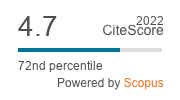The behaviour of Myrothecium roridum, artificially inoculated on cultivated rocket (Eruca sativa), has been evaluated under eight different temperature and CO2 concentration combinations (from 14-18 °C to 26-30 °C and with 400-450 or 800-850 ppm of CO2). The pathogen isolate used for this study was inoculated on rocket and disease severity increased with high temperatures for both CO2 levels. Verrucarin A and roridin E mycotoxins were produced under all the tested temperatures at high CO2 conditions. The maximum level of verrucarin A was found at 14-18 °C and 800-850 ppm of CO2, and the maximum roridin E production was detected at 26-30 °C with 800-850 ppm of CO2. The results obtained in this study show that both the CO2 concentration and the temperature influence disease severity and mycotoxin production in different ways. An increase in temperature, which is favourable for attacks of the pathogen, could induce the spread of M. roridum in temperate regions, and this pathogen could take on even greater importance in the future, considering its ability to produce mycotoxins.
RESEARCH ARTICLE
Verrucarin A and roridin E produced on rocket by Myrothecium roridum under different temperatures and CO2 levels
P. Bosio Related information
1AGROINNOVA – Centre of Competence for the Innovation in the Agro-Environmental Sector, University of Torino, Largo Paolo Braccini 2, Grugliasco 10095, Italy.
*Corresponding author: pietro.
, I. Siciliano Related information*Corresponding author: pietro.
1AGROINNOVA – Centre of Competence for the Innovation in the Agro-Environmental Sector, University of Torino, Largo Paolo Braccini 2, Grugliasco 10095, Italy.
, G. Gilardi Related information1AGROINNOVA – Centre of Competence for the Innovation in the Agro-Environmental Sector, University of Torino, Largo Paolo Braccini 2, Grugliasco 10095, Italy.
, M.L. Gullino Related information1AGROINNOVA – Centre of Competence for the Innovation in the Agro-Environmental Sector, University of Torino, Largo Paolo Braccini 2, Grugliasco 10095, Italy.
2DISAFA – Department of Agricultural, Forest and Food Science, University of Torino, Largo Paolo Braccini 2, Grugliasco 10095, Italy.
, A. Garibaldi Related information2DISAFA – Department of Agricultural, Forest and Food Science, University of Torino, Largo Paolo Braccini 2, Grugliasco 10095, Italy.
1AGROINNOVA – Centre of Competence for the Innovation in the Agro-Environmental Sector, University of Torino, Largo Paolo Braccini 2, Grugliasco 10095, Italy.
World Mycotoxin Journal: 10
(3)- Pages: 229 - 236
Published Online: August 31, 2017
Abstract
Keywords: Eruca sativa, phytotron, mycotoxins, HPLC-MS/MS, climate change
2023 Journal Impact Factor
2.0
source: Journal Impact Factor 2023™ from Clarivate™

Institutional Offers
For institutional orders, please contact [email protected].
Purchase Options
-
P. Battilani and M. Camardo Leggieri
-
F. Xu, R.C. Baker, T.B. Whitaker, H. Luo, Y. Zhao, A. Stevenson, C.J. Boesch and G. Zhang
-
A.O. Aasa, F.F. Fru, O.A. Adelusi, S.A. Oyeyinka and P.B. Njobeh
-
R. Barkai-Golan and N. Paster
-
F. Wu
-
V. Ostry
-
R. Bandyopadhyay, A. Ortega-Beltran, A. Akande, C. Mutegi, J. Atehnkeng, L. Kaptoge, A.L. Senghor, B.N. Adhikari and P.J. Cotty
-
A. Logrieco, A. Moretti and M. Solfrizzo
-
G. Schatzmayr and E. Streit
-
B. Grenier and I. Oswald



